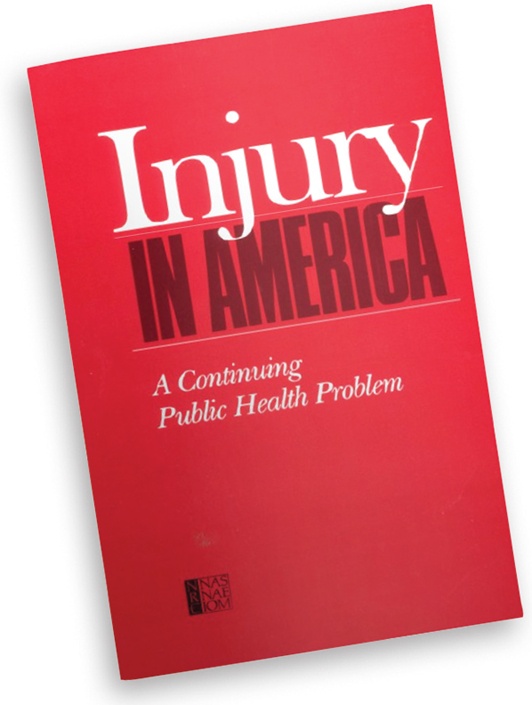Injury and Violence Prevention:
Ensuring Protection in the Workplace and Daily Life

Injuries are not accidents—they are predictable, preventable, and controllable. But workplaces and the circumstances of daily life are changing and posing new kinds of risks. The scientific study of injury and systemic approaches to risk management have greatly reduced work-associated injuries while improving safety in and out of workplaces. These efforts will need to continue as workplaces and daily life continue to change.

1970
Prioritizing Worker Safety
Amid increasing rates of workplace injuries and illnesses, the Occupational Safety and Health Act was signed into federal law in 1970. Known initially as “the safety bill of rights,” the act was designed to ensure that all Americans have safe working conditions. The act established three permanent agencies to fulfill this mission—the Occupational Safety and Health Administration (OSHA) to enforce the act, the National Institute for Occupational Safety and Health to conduct research, and the Occupational Safety and Health Review Commission to adjudicate enforcement actions challenged by employers. With a 40 percent reduction in the occupational injury and illness rate since OSHA was launched, the act has fostered great progress in creating safer workplaces.

1977
Miners’ Safety
Deaths and injuries in the mining industry spurred the passage of the Federal Mine Safety and Health Act of 1977, commonly known as the Mine Act, which established a comprehensive set of laws to improve working conditions and benefits for miners in the United States. The act consolidated regulations and oversight groups under one organizational structure, mandated mine inspections, and improved the safety net for miners who suffered from work-related conditions such as black lung disease. Mining fatalities dropped sharply under the Mine Act, and the legislation continues to undergird safety regulations and miner benefit programs today.

1984
Automobile Safety
After a decade of controversy over safety belt laws and the role of government regulation in a free society, New York passed the first mandatory seatbelt law in 1984. New Jersey quickly followed suit, but many states rejected mandatory seatbelt legislation. However, over the following decade, many states reversed their initial rulings, with only New Hampshire continuing to hold out against mandatory seatbelt laws. Thanks to seatbelt legislation, auto safety features such as airbags, and improved testing, far fewer mortalities occur on highways today, mile for mile, than in the past.

1986
The Origins of Safety Culture
The International Nuclear Safety Advisory Group was the first to use the term “safety culture” in a 1986 report investigating the Chernobyl disaster, citing a “poor safety culture” as one of the factors contributing to the disaster. Since then, many definitions of safety culture have emerged, but all emphasize people’s values, attitudes, beliefs, and behaviors and how these are spread throughout an organization. Many industries have embraced the concept of safety culture to reduce injury and fatality rates and maintain a safe work environment.


1993
Firearm Safety
The Firearm Owners’ Protection Act of 1986 ended many previous restrictions on sellers of firearms, but the Brady Handgun Violence Protection Act of 1993 reimposed restrictions by requiring that background checks be completed before a gun is purchased from a licensed dealer. The passage of the Federal Assault Weapons Ban in 1994 further restricted the commercial availability of firearms, prohibiting the manufacture, transfer, and possession of semi-automatic weapons as well as the transfer and possession of large-capacity ammunition feeding devices, though Congress allowed this ban to expire in 2004. Today, high rates of gun violence continue to fuel the controversy over firearm safety and regulation.

1991
Standards to Address Biological Hazards
Workers in many occupations, including first responders, housekeeping personnel, and health care workers, may all be at risk for exposure to bloodborne pathogens such as hepatitis B, hepatitis C, and human immunodeficiency virus. To address this risk, the Occupational Safety and Health Administration published the Occupational Exposure to Bloodborne Pathogens Standard in 1991, which sets forth requirements for employers with workers who are exposed to blood or other potentially infectious materials. Since the bloodborne pathogens standard was published, many different medical devices have emerged that reduce the risk of needlesticks and other sharps injuries, and a 2001 revision to the standard established further requirements for employers to reduce hazards to workers.

1992
Consolidating Injury Prevention and Control
The 1985 Institute of Medicine report Injury in America cited the inadequacy of injury prevention efforts and called for the establishment of a central agency to coordinate research efforts in injury prevention. Following the establishment of a national injury prevention research effort led by the Centers for Disease Control and Prevention, the National Center for Injury Prevention and Control (NCIPC) was launched in 1992 to focus specifically on scientific measures to improve public health. Using surveillance, risk factor identification, intervention, and evaluation of injury prevention programs, the NCIPC works in partnership with other groups to reduce the incidence, severity, and adverse outcomes of injuries in the United States.

1996
A Workplace Safety Research Agenda
The continuing burden of work-related diseases, injuries, and deaths spurred the National Institute for Occupational Safety and Health to work with the occupational safety and health community to develop a National Occupational Research Agenda in 1996. The agenda identified 21 priority research areas grouped into three categories: disease and injury, work environment and workforce, and research tools and approaches. The agenda has led to many partnerships among federal, non-federal, and private groups to fund, promote, update, and coordinate the identified research priorities.

2003
Protections for Servicemembers
The Servicemembers Civil Relief Act, enacted in 2003 and amended several times since, provided a wide range of legal protections to all active duty service members, reservists, and members of the National Guard. Provisions covered by the act include rental agreements, security deposits, prepaid rent, evictions, installment contracts, credit card interest rates, mortgage interest rates, mortgage foreclosures, civil judicial proceedings, automobile leases, life insurance, health insurance, income tax payments, and protections for dependents. Taken as a whole, the act aimed to ensure that servicemembers can focus on accomplishing their missions without worrying about legal entanglements.
Most injuries are preventable. The challenge therefore is to design, identify, implement, and enforce the most effective preventive programs and policies. The result will be fewer injuries inside and outside of workplaces.




